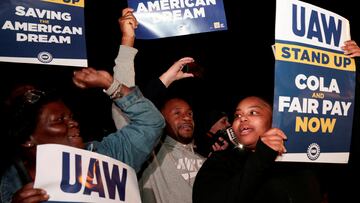How will the UAW strike impact car prices?
The Big 3 automakers have made $20 billion in profits this year as workers struggle for better pay and conditions. How could the strike impact car prices?

For the first time in the history of the United Auto Workers, members are on strike against the Big 3 automotive companies: Ford, GM, and Stellantis. The union is taking a non-traditional approach to its strike, calling on specific local chapters at certain production sites to strike. UAW President Shawn Fain has made clear that if the company continues to stall, more chapters will be called on to participate in the work stoppage. Automotive executives have started running to corporate media outlets to invalidate the demands being made by the UAW, which include a forty-percent pay increase over the next four years and a transition to a four-day workweek. The CEOs at the three companies have seen their pay increase forty percent over the last four years. The union argues that if executives have earned such high raises, then the workers who generate those profits deserve similar pay increases.
How will the strike impact car prices and profits?
The Big 3 companies have made over $20 billion in profits this year alone, which is no surprise considering that the average price of a new car has increased 22.8 percent over the last four years. By comparison, from 2015 to 2019, the average cost of a new car fell by 1.7 percent. The high profits seen by these companies over the last four years show that inflation is not hurting their bottom line.
Profit is, by definition, the revenue left over after a business accounts for all of its costs. If those costs increase, a company has two options: lowering its profit margin or increasing its prices to regain its profit margin. Automotive companies went with the second option, and their record-breaking profits show that they actually increased beyond what would have been necessary to maintain their previous margin.
Whether or not these companies will exploit the strike to increase car prices even further remains to be seen. The strike, like all work stoppage, aims to hurt the company’s bottom line to encourage corporate leaders to meet worker demands. Passing along the costs of the strike to customers is unlikely to garner public support, particularly after a recent Gallup poll found that seventy-five percent of those surveyed supported the UAW members.
The union is looking for pay that reflects the value created by its members
Ford CEO Jim Farley told CNBC that the UAW’s requests would bankrupt the company.
The union rejects these claims and has said that the company could keep prices where they are, double the pay of all workers, and still rake in billions in profits. Farley also argued that the demands would mean that including the value of each worker’s benefits, the average cost per employee would be $300,000, and that compared to teachers or members of the military, that is far too much. This line of thinking shows that Farley does not see employee pay as related to the value that the workers create for Ford. Instead, an employee’s pay should be reflective of what the average worker in the society is making. The union strongly disagrees and would encourage any worker who labors under poor conditions and lousy pay to fight for improvements, just as their members are doing.
Ford has published various press releases touting what executives feel is a generous offer to its workers. However, no numbers have been published. The union is asking for a forty percent increase, and Ford only reports offering a significant increase in wages. Significant is not an objective indicator, and it is clear that to the union, the offer does not meet that standard.






